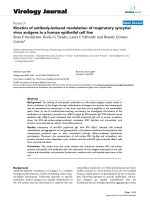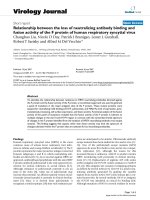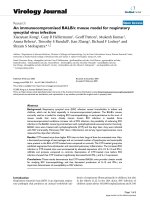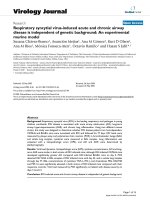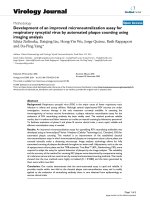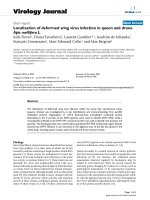Incidence of respiratory syncytial virus infection in children with congenital heart disease undergoing immunoprophylaxis with palivizumab in Pará state, north region of Brazil
Bạn đang xem bản rút gọn của tài liệu. Xem và tải ngay bản đầy đủ của tài liệu tại đây (558.23 KB, 6 trang )
Souza et al. BMC Pediatrics
(2019) 19:299
/>
RESEARCH ARTICLE
Open Access
Incidence of respiratory syncytial virus
infection in children with congenital heart
disease undergoing immunoprophylaxis
with palivizumab in Pará state, north region
of Brazil
Roseane Porfírio de Souza1,2, Andre Luis Ribeiro Ribeiro3, Sílvio Augusto Fernandes de Menezes4 and
Luiz Fernando Almeida Machado1,5*
Abstract
Background: Palivizumab prophylaxis for the human respiratory syncytial virus (HRSV) has been reported to reduce
the risk of hospital admissions related to HRSV in children with congenital heart disease (CHD). These children are
at high risk of developing severe lower respiratory tract infection (LRTI) due to HRSV infection. Our goal was to
evaluate the incidence of HRSV infection in children with CHD after being submitted to immunoprophylaxis with
palivizumab in Pará state, North region of Brazil.
Methods: A prospective and observational cohort study was performed in children ≤2 years of age with CHD who
received palivizumab immunoprophylaxis between January 1 and June 31, 2016. A questionnaire about basic nonmedical care measures was applied to parents/legal representatives. Data on patients’ demographic characteristics,
household environment, and respiratory infections were evaluated. HRSV infection was determined by qPCR.
Results: There were 104 children enrolled in this investigation and the results showed a mean age of 10.6 months,
an average weight of 7.3 kg and 3.5 doses of palivizumab per children during seasonality of HRSV. Respiratory
infection was observed in 27.9% of cases, of which 9.6% were LRTI. No case of children who received palivizumab
immunoprophylaxis and developed influenza-like symptoms tested positive for HRSV.
Conclusion: Although the lack of a control group doesn’t allow to affirm the effectiveness of HRSV passive
immunization, the immunoprophylaxis with palivizumab appeared to be totally efficient in preventing respiratory
infection by HRSV in children up to two years of age with CHD.
Keywords: Respiratory syncytial virus, Immunization, Palivizumab, Respiratory tract infections
Background
The human respiratory syncytial virus (HRSV) is the most
common etiologic agent of acute lower respiratory tract infection (LRTI) in neonates and children under five years of
age worldwide [1] and it is the fourth cause of death in this
* Correspondence:
1
Biology of Infectious and Parasitic Agents Post-Graduate Program, Federal
University of Pará, Belém, Pará, Brazil
5
Virology Laboratory, Institute of Biological Sciences, Federal University of
Pará, Cidade Universitária Prof. José da Silveira Netto, Rua Augusto Correa 1,
Guamá, 66.075-110, Belém, Pará, Brazil
Full list of author information is available at the end of the article
group of children in Brazil [2]. HRSV infection is associated
with risk factors such as overpopulation, pollution and malnutrition [3]. Children with congenital heart disease (CHD)
are at high risk of developing acute LRTIs, and HRSV infection increases the chances of developing more severe LRTIs
and extends the length of hospitalization because of respiratory complications. It increases not only the morbidity and
mortality rates of these children but also the treatment
costs due to higher admission rates in intensive care units,
longer oxygen therapy and mechanical ventilation among
those children [4]. It is estimated that 3.4 million
© The Author(s). 2019 Open Access This article is distributed under the terms of the Creative Commons Attribution 4.0
International License ( which permits unrestricted use, distribution, and
reproduction in any medium, provided you give appropriate credit to the original author(s) and the source, provide a link to
the Creative Commons license, and indicate if changes were made. The Creative Commons Public Domain Dedication waiver
( applies to the data made available in this article, unless otherwise stated.
Souza et al. BMC Pediatrics
(2019) 19:299
hospitalizations and 199,000 deaths occur globally as a result of HRSV infection [1].
HRSV infections occur predominantly in well-defined
seasons, usually during autumn and winter, and in temperate and subtropical regions. These seasons last between 16 to 20 weeks annually [5, 6] and often matches
with the seasonality of the influenza virus [7]. The prevalence of HRSV infection in Brazil is derived from the
data of the Influenza Sentinel Surveillance Information
System and other respiratory viruses (SIVEP-FLIPE). It
was based on data from influenza-like reports of illness
during the period of 2007 to 2014. This data showed
that HRSV infection has a different seasonality depending on the region in the country [8]. Based on that, the
Ministry of Health (Joint Technical Note no. 05/2015)
defined the regional seasonality of HRSV infection in
different regions in Brazil, which in the North region
corresponds to the period from January to June [8].
Although HRSV infection activates the immune system, acquired immunity does not prevent reinfection
and vaccination with attenuated viruses appears to aggravate subsequent diseases [9]. Thus, the Ministry of
Health of Brazil [10] has established measures to reduce
the transmission of HRSV with passive immunization
using the monoclonal antibody palivizumab (Synagis,
MedImmune Laboratory, Gaithersburg, USA), which is
composed of 95% human and 5% murine amino acid sequences. It was established by law and includes a population of preterm babies (< 28 weeks) who are not older
than 12 months; and children up to two years of age
with either CHD with hemodynamic significance or with
chronic lung disease. Administration of palivizumab is
performed intramuscularly at a dose of 15 mg/kg [11].
So far, no epidemiologic survey has been performed to
check the efficacy of the palivizumab program since it’s
beginning in Pará state. Thus, this study aimed to evaluate the incidence of HRSV in children (< 2 years of age)
with CHD who were submitted to immunoprophylaxis
with palivizumab in Belém, Pará, Brazil. This study also
investigated the knowledge of children’s parents/legal
representatives regarding basic non-medical care measures to reduce HRSV transmission; the efficiency of the
palivizumab program and its recommended monthly
doses; and analysed the incidence of respiratory infections caused by HRSV in children after palivizumab
immunization in a specialized reference hospital in cardiology in Belém, Brazil.
Materials and methods
Study design, population studied and ethical aspects
This was a prospective observational cohort study involving children with CHD who were participating of
the palivizumab program attending various sectors (e.g.
outpatient clinic, neonatal intensive care unit, paediatric
Page 2 of 6
clinic and intensive care unit and paediatrics) of the
Gaspar Vianna Public Foundation Hospital (FHCGV).
This is specialized and a reference hospital in cardiology
located in Belém, Pará, Brazil. The FHCGV carries out
the assistance program for children with cardiopathy
(PAPCC), where children receive outpatient care from
nurses, social workers, psychologists, nutritionists, dentists, paediatricians and paediatric cardiologists. All children with CHD enrolled in the PAPCC whose parents/
legal representatives agreed to join the study and received palivizumab immunoprophylaxis for HRSV from
January to June 2016 were included in our sample.
This study was approved by the Ethics Committee of
the Gaspar Vianna Public Foundation Hospital under
protocol number 53017116.5.0000.0016, according to
the resolution 466/2012 of the National Health Council.
The parents or legal guardians of the participant children signed an informed consent form and answered
questions regarding basic non-medical care measures to
reduce HRSV transmission. The questionnaire included
8 qualitative yes / no questions.
Inclusion and exclusion criteria
All children younger than 2 years of age from both sexes,
who had CHD with confirmed haemodynamic significance and received at least one dose of palivizumab during
the study period were included. To receive palivizumab
immunoprophylaxis, the child should fill the criteria
established by the FHCGV outpatient clinic: 1- to be selected according to the protocol for the palivizumab program; 2- to be prescribed by a paediatrician or paediatric
cardiologist 3- to have determined the full treatment
(number, timing and concentrations of palivizumab
doses); 4- received the complete guidelines of treatment;
5- to have all palivizumab doses recorded on the medical
records. Children who received the treatment but failed to
return for taking subsequent doses or did not show up on
follow-up appointments were excluded from our samples.
Sampling and follow-up
On the day of administration of the first palivizumab dose,
all children were weighted and reviewed by a paediatrician
or paediatric cardiologist. Palivizumab doses were calculated and the overall clinical conditions checked before
drug administration. Doses were calculated using the following formula: weight in kilos times 15 (ideal dose/kg of
palivizumab) divided by 100 (the concentration of palivizumab in mg/mL in use). Hospitalized children were evaluated by the assistant paediatrician.
Palivizumab immunization was carried out in monthly
doses and the total number of doses taken was based on
the time of enrolment in the program. Children who
were enrolled in January could take a total of 6 doses,
however, those who enrolled after January were given
Souza et al. BMC Pediatrics
(2019) 19:299
the same monthly dose, which resulted in a lower number
of total doses taken. Parents or legal representatives were
invited to participate in this study and those who agreed
to join in, signed the consent form and answered a questionnaire. An active search for clinical manifestations suggestive of HRSV infection post-immunoprophylaxis with
palivizumab was carried out through phone calls monthly.
Palivizumab treatment records
A structured form was used to record the palivizumab
doses taken and post-immunoprophylaxis follow-up.
During the study, it was established that any child who
developed influenza-like symptoms (cough or sore
throat, rhinorrhoea, coryza and malaise) should come to
the outpatient clinic of the FHCGV from Monday to Friday, no later than the fifth day of the beginning of symptoms. All children with influenza-like symptoms were
tested according to the protocol of the Global Influenza
Program [12] to investigate respiratory infection caused
by HRSV, which also included those children who developed LRTI and required hospitalization. Tests for HRSV
infection and other respiratory viruses were performed
in the Central Public Health Laboratory of Pará
(LACEN-PA).
HRSV infection was determined by quantitative polymerase chain reaction (qPCR), which is considered one
of the most accurate tests for detecting HSRV strains
[13]. Amplicons signals were measured relative to the internal reference dye (ROX) to normalize for non-PCRrelated fluorescence fluctuations occurring from well to
well. The qPCR protocol used was standardized by the
Centre for Disease Control and Prevention (CDC), Ministry of Health of Brazil and its efficiency has been
largely tested across the country. Positive results were
determined by the fluorescence intensity values of our
samples compared to a positive control previously established by the CDC.
Data from cases that developed LRTI caused by HRSV
were retrieved from medical records. Information regarding the length of stay during hospitalization, number of
doses of palivizumab received, use of supplementary oxygen and mechanical ventilation, intensive care unit (ICU)
admission, and death was collected. Furthermore, additional information included the seasonality of the HSRV
infection, the beginning and ending of treatment, and
other upper and lower respiratory tract infection. In this
study, the cities of Ananindeua, Marituba, Benevides,
Santa Bárbara do Pará, Santa Isabel do Pará and Castanhal
were considered as the Belém metropolitan area.
Data analysis
Data were inputted on Microsoft® Access 2010 database
and summarized in tables. The following variables were
considered: the geographical location, other preventive
Page 3 of 6
HSRV infection measures (apart from palivizumab immunoprophylaxis), children’s demographic data on the day of
the first dose (age, gender, weight), follow-up period, volume and number of doses of palivizumab prescribed.
Results
There were 104 children who fulfilled the inclusion criteria and received immunoprophylaxis with palivizumab
from January to June 2016 at the FHCGV in Belém, Pará.
One child was excluded because the treatment with palivizumab was administered for a non-cardiologic reason.
Eight questions were asked to children’s parents or
legal representatives about their knowledge of basic nonmedical measures to reduce the transmissibility of
HRSV. Results showed that 77% (80/104) of the children’s parents or legal representatives knew about the
need of washing hands to prevent virus transmission;
70% (73/104) performed hands hygiene before and after
contact with the child; and 69% (72/104) had been advised of avoiding exposure of the child to passive smoking. Answers to all questions of the questionnaire are in
Table 1.Two-thirds of these measures were known by
children’s parents or legal representatives and less than
half of them were aware of vaccination against influenza
virus as preventive care.
There were 58% (60/104) of males and 42% (44/104)
of females. The geographical location indicated that 54%
(56/104) of participants came from the countryside, 29%
(30/104) lived in the city of Belém, and 17% (18/104)
were residents from the Belém metropolitan area. The
FHCGV outpatient clinic was responsible for 81% (84/
104) of the source of participants, 10% (11/104) was
assisted on the paediatric clinic, 6% (6/104) came from
neonatal ICU and 3% (3/104) from other sectors of the
hospital. The beginning of immunoprophylaxis with palivizumab was in January for 32% (33/104) of the cases,
Table 1 Analysis of the knowledge of parents and legal
representatives of children who received immunoprophylaxis
with palivizumab at the FHCGV from January to June of 2016
on general measures of non-drug basic care to reduce the
transmissibility of HRSV
Preventive HRSV infection measures
n
%
Appropriated hand hygiene
80
76.9
Cleaning of hands before and after contact with the child
73
70.2
Avoid exposure of the child to passive smoking
72
69.2
Reinforcement of the child personal hygiene
71
68.3
Disinfection of contaminated surfaces
71
68.3
Limit contact with people with a respiratory infection
69
66.4
Avoid agglomerations
67
64.4
Vaccination against influenza virus
49
47.1
Total
66.3
Souza et al. BMC Pediatrics
(2019) 19:299
Page 4 of 6
followed by February with 26% (27/104) and March with
19% (20/104).
Palivizumab immunoprophylaxis was given only during the regional epidemic season of HRSV (January to
June). Children who started the immunization in January
had a chance to take all the six doses; the others were
given monthly doses according to the month of enrolment until June. Of all participating children, only 17
(16.3%) had received 6 doses of palivizumab during the
study and 24 (23.0%) received two doses. Demographic
data including palivizumab treatment information is
shown in Table 2.
The average age during the beginning of palivizumab
immunoprophylaxis was 10.6 months (SD ± 6.6), mean
weight was 7.3 kg (SD ± 2.7), average dose of palivizumab
was of 1.1 mL (SD ± 0.4) and the mean number of doses
given during the study was 3.5 (SD ± 1.7).
Table 2 Demographic data of children with CHD who received
immunoprophylaxis with palivizumab at the FHCGV from
January to June 2016, in Belém, Pará, Brazil
Characteristics
n
%
Male
60
57.7
Female
44
42.3
Gender
Geographic origin
Belém
30
28.8
Belém metropolitan area
18
17.3
Countryside
56
53.9
Outpatient clinics
84
80.8
Esternal outpatient clinics
3
2.9
Paeditrics clinics
11
10.5
6
5.8
Hospital sector of origin
Neonate ICU
Month of the beginning of immunoprophylaxis
January
33
31.7
Medical records showed that 28% (29/104) of children
had at least one episode of respiratory tract infection,
with a ratio of 1.3 episodes of infection per patient (SD ±
0.4). It resulted in 40 respiratory infections during the
period of study.
Thirty out of 40 respiratory infections (75%) were on
the upper respiratory tract and 10 (25%) involved the
lower respiratory tract (Table 3). The mean length of
stay in the hospital due to these infections was 51 days
(SD ± 35). From those children who developed LRTI,
10% (1/10) presented bronchiolitis, 50% (5/10) had
pneumonia, and 10% (1/10) developed both, bronchiolitis and pneumonia. Admission to ICU due to LRTI was
required for 50% (5/10) of children and the average
length of stay in the ICU was 24 days. From these children, 40% (4/10) required only oxygen therapy and 30%
(3/10) needed mechanical ventilation (Table 4). During
the LRTI, the nasopharyngeal aspirate was positive for
metapneumovirus in 20% (2/10) of the cases. In the follow-up period, one child has passed away 0.9% (1/104)
due to a non-respiratory cause after cardiac surgery.
Discussion
To our knowledge, this is the first study in the North region of Brazil that investigated the incidence of HRSV infection after the use of palivizumab passive immunization
in children with CHD. Our results showed that there was
not even a single case of HRSV positive test after palivizumab immunization.
Although the incidence of HRSV in children with CHD
in this region is not known, data from the influenza sentinel surveillance system (SIVEP-Gripe) indicated a prevalence of 9.6% of HSRV positivity in children younger than
5 years of age with influenza-like symptoms [14]. Other
studies that focused on a population with a similar age
(younger than 2 years), showed a prevalence of 52% of
HRSV infection in children with acute respiratory tract infections (São Paulo, Brazil) [15] and 40.2% in children with
LRTI in the Northeast region [16]. Since 29 (27.9%) of the
participant children in this study had a respiratory infection, it was expected that at least a few children would be
infected by the HSRV, the most common aetiological
agent in this type of infections [15, 16]. However, no case
February
27
26.0
March
20
19.2
April
10
9.6
May
10
9.6
June
4
3.8
1 dose
16
15.4
Respiratory infection information
n
%
2 doses
24
23.1
Upper respiratory tract infection (URTI)
30
28.8
3 doses
15
14.4
Lower respiratory tract infection (LRTI)
10
9.6
4 doses
13
12.5
Diagnosis in outpatient clinic
27
26.0
5 doses
19
18.3
LRTI acquired during hospitalization
3
2.9
6 doses
17
16.3
Hospitalization due to respiratory infection
7
6.8
Number of palivizumab doses taken
Table 3 Incidence of respiratory tract infection in 104 children
with congenital heart disease after immunoprophylaxis with
palivizumab in Belém, Brazil from January to June 2016
Souza et al. BMC Pediatrics
(2019) 19:299
Page 5 of 6
Table 4 Diagnostic and medical care needed for treating 10
children who developed lower respiratory tract infection (LRTI)
after immunoprophylaxis with palivizumab in the Belém, Brazil
from January to June 2016
LRTI information
n
%
Pneumonia
5
50
Metapneumovirus infection
2
20
Bronchiolitis
1
10
Bronchiolitis and pneumonia
1
10
ICU admission
5
50
Oxygen therapy use
4
40
Mechanical ventilation use
3
30
of HRSV infection was identified in our sample, suggesting
that palivizumab immunization was effective in preventing
respiratory infections caused by HRSV.
Children started immunoprophylaxis with palivizumab
with a mean age of 10.6 months, which was older than
that found in São Paulo (8.4 months) [17] and in children with heart disease in Korea (2.9 months) [18]. The
mean weight of the participant children during the first
dose of treatment was 7.3 kg and resulted in an average
dose of 1.1 mL of palivizumab (100 mg/mL), in accordance with the standards of the Brazilian Ministry of
Health [10].
The average number of doses of palivizumab injections
during the study period was 3.5 doses/child, similar to
that reported in Korea (3.7 doses) [18], Latin America
(3.8 doses) [19] and in São Paulo (4 doses) [17]. Five
doses of palivizumab were given to 34.6% of children, a
percentage higher than reported in São Paulo (22.7%)
[17] but lower than in Latin America (43.7%) [19]. Since
palivizumab is only administered during the HRSV epidemic season (January to June in the North region of
Brazil), the reduced number of doses could be a result of
the difficulties of countryside children travelling to
Belém in order to take their medication. It is important
to mention that the Pará state has a huge territorial extension and the transportation system is poor, making
the commuting from their hometown to Belém a challenging task. Thus, only children who started immunoprophylaxis during the months of January and February
had the chance of receiving 5 doses.
There were 40 respiratory infections in 29 children
(28%) with predominantly upper respiratory tract infections. Similar results were observed in Argentina (32%)
[20] and much lower than in Korean children (61%)
[18], Italy (76.4%) [21] and São Paulo (59.1%) [17]. We
also identified an overall low incidence of LRTI (9.6%),
which is much lower than that reported in São Paulo
(40.6%) [17]. However, it may reflect differences in the
studied population that did not include children with
chronic lung disease in our study. Hospitalization was
barely required (6.8%), which was lower than São Paulo
(9%) [17], and even much lower than in Italy (22.9%)
[21], Argentina (31%) [20] and Korea (60%) [18].
All children participating in this study had taken at
least 1 dose palivizumab immunoprophylaxis while free
of respiratory infections. Those children who developed
a respiratory infection were previously passively immunized against HRSV. Since the immunization is passive,
maintenance of the regular monthly immunization is the
key point for preventing HRSV infection and it is not related to the total number of doses.
Although uncommon, when hospitalization was required, patients stayed for a long period (average of 51
days). It reflects the vulnerability of this specific population that have other medical problems requiring treatment, which can be aggravated due to their susceptibility
to several other viral and bacterial infections. This long
hospitalization stay is a result of a combination of other
associated medical problems and excessive bureaucracy
and slowness of the Brazilian public health system.
The respiratory infections found in this study were
classified as bronchiolitis in 10% of cases, lower than in
São Paulo (50%) [17] and Italy (22.9%) [21]. We did not
observe any case of HRSV infection, suggesting a full efficacy of palivizumab immunoprophylaxis. However, we
can not affirm its effectiveness since we did not include
a control group of similar patients who did not take the
passive immunization with palivizumab.
Conclusion
The use of palivizumab immunoprophylaxis appeared to
be effective in preventing HRSV infection, especially the
LRTI in children CHD. Although respiratory infections
were present in 27.9% of children enrolled in our study,
none of them tested positive to HRSV, which reinforces
the suggested efficacy of the palivizumab passive
immunization, carried out by the Brazilian Ministry of
Health for children with CHD, in preventing the incidence and complications related to respiratory infections
caused by HRSV.
Abbreviations
CHD: congenital heart disease; FHCGV: Gaspar Vianna Public Foundation
Hospital; HRSV: human respiratory syncytial virus; LACEN-PA: Central Public
Health Laboratory of Pará; ICU: intensive care unit; LRTI: lower respiratory
tract infections; PAPCC: assistance program for children with cardiopathy;
SIVEP-FLIPE: Influenza Sentinel Surveillance Information System and other
respiratory viruses
Acknowledgements
The authors thank the Secretaria de Saúde do Município de Belém – Brasil,
the director board of the Centro de Atendimento em Doenças Infecciosas
Adquiridas (CASA-DIA), and all participants of this study.
Authors’ contributions
RPS and LFAM have contributed to the consemption and design of this
study. RPS has performed data acquisition. ALRR and SAFM have analyzed
and interpreted the data. RPS, LFAM and ALRR have drafted and revised the
Souza et al. BMC Pediatrics
(2019) 19:299
work. All authors have approved the submitted version, agreed to author’s
personal contributions and ensure the accuracy and integrity of this work.
Funding
This study was fnanced in part by the Coordenação de Aperfeiçoamento de
Pessoal de Nível Superior - Brasil (CAPES) - Finance Code 001. PAPQ,
PROPESP/FADESP of the Federal University of Pará, supported the
publication of this article. These funding bodies have agreed to pay the
article processing charges.
The author Andre Luis Ribeiro Ribeiro is grateful to the CNPq for his
postdoctoral scholarship. CNPq - Brazil (n° 153811/2018–8).
The funding bodies did not have any role in designing the study; collecting,
analysing, and interpretating the data; and in writing the manuscript.
Page 6 of 6
8.
9.
10.
11.
12.
Availability of data and materials
Not applicable.
13.
Ethics approval and consent to participate
This study was approved by the Ethics Committee of the Gaspar Vianna
Public Foundation Hospital under protocol number 53017116.5.0000.0016.
Although no individual person detail is shown in this work, all parents or
legal guardians signed a consent form.
Consent for publication
Not applicable.
Competing interests
The authors declare that they have no competing interests.
Author details
Biology of Infectious and Parasitic Agents Post-Graduate Program, Federal
University of Pará, Belém, Pará, Brazil. 2Gaspar Vianna Clinic Hospital
Foundation, Belém, Pará, Brazil. 3Postdoctoral fellowship, Cell Culture
Laboratory, School of Dentistry, Federal University of Para – UFPA, Belém,
Pará, Brazil. 4Clinical lecturer, Department of Periodontology, School of
Dentistry, University Centre of Para – CESUPA, Belém, Pará, Brazil. 5Virology
Laboratory, Institute of Biological Sciences, Federal University of Pará, Cidade
Universitária Prof. José da Silveira Netto, Rua Augusto Correa 1, Guamá,
66.075-110, Belém, Pará, Brazil.
14.
15.
16.
1
Received: 23 January 2019 Accepted: 21 August 2019
References
1. Nair H, Nokes DJ, Gessner BD, Dherani M, Madhi SA, Singleton RJ, et al.
Global burden of acute lower respiratory infections due to respiratory
syncytial virus in young children: a systematic review and meta-analysis.
Lancet. 2010;375:1545–55.
2. Ferone EA, Berezin EN, Durigon GS, Finelli C, FelÌcio MC, Storni JG, et al.
Clinical and epidemiological aspects related to the detection of adenovirus
or respiratory syncytial virus in infants hospitalized for acute lower
respiratory tract infection. J Pediatr. 2014;90(1):42–9.
3. Law BJ, Langley JM, Allen U, Paes B, Lee DS, Mitchell I, et al. The Paediatric
investigators collaborative network on infections in Canada study of
predictors of hospitalization for respiratory syncytial virus infection for
infants born at 33 through 35 completed weeks of gestation. Pediatr Infect
Dis J. 2004;23(9):806–14.
4. MacDonald NE, Hall CB, Suffin SC, Alexson C, Harris PJ, Manning JA.
Respiratory syncytial viral infection in infants with congenital heart disease.
N Engl J Med. 1982;307(7):397–400.
5. Zachariah P, Shah S, Gao D, Simões EA. Predictors of the duration of the
respiratory syncytial virus season. Pediatr Infect Dis J. 2009;28(9):772–6.
6. Schmidt R, Majer I, García Román N, Rivas Basterra A, Grubb E, Medrano
López C. Palivizumab in the prevention of severe respiratory syncytial virus
infection in children with congenital heart disease; a novel cost-utility
modeling study reflecting evidence-based clinical pathways in Spain. Health
Econ Rev. 2017;7(1):47.
7. Reis J, Shaman J. Retrospective parameter estimation and forecast of
respiratory syncytial virus in the United States. PLoS Comput Biol. 2016;
12(10):e1005133.
17.
18.
19.
20.
21.
Brasil. Ministério da Saúde. Nota Técnica Conjunta n° 05 de 09 de fevereiro
de 2015. Estabelece a Sazonalidade do Vírus Sincicial Respiratório no Brasil e
Oferece Esclarecimentos Referentes ao Protocolo de Palivizumabe. Brasília:
Ministério da Saúde; 2015.
Andabaka T, Nickerson JW, Rojas-Reyes MX, Rueda JD. Bacic Vrca V, Barsic B.
monoclonal antibody for reducing the risk of respiratory syncytial virus
infection in children. Cochrane Database Syst Rev. 2013;30(4):CD006602.
da Saúde M. Portaria no 522, de 13 de maio de 2013. Aprova o protocolo
de uso do palivizumabe. Diário Oficial da União. 2013;14:mai.
European Medicines Agency (EMA). Summary of Product Characteristics
Synagis 50 mg (palivizumab) 2009. Accessed on 01st May 2019 in https://
www.ema.europa.eu/en/documents/product-information/synagis-eparproduct-information_en.pdf
Broadbent L, Groves H, Shields MD, Power UF. Respiratory syncytial virus, an
ongoing medical dilemma: an expert commentary on respiratory syncytial
virus prophylactic and therapeutic pharmaceuticals currently in clinical trials.
Influenza Other Respir Viruses. 2015;9(4):169–78.
van Elden LJR, van Loon AM, van der Beek A, Hendriksen KAW, Hoepelman
AIM, van Kraaij MGJ, Schipper P, Nijhuis M. Applicability of a real-time
quantitative PCR assay for diagnosis of respiratory syncytial virus infection in
immunocompromised adults. J Clin Microbiol. 2003;41(9):4378–81.
Freitas AR, Donalisio MR. Respiratory syncytial virus seasonality in Brazil:
implications for the immunisation policy for at-risk populations. Mem Inst
Oswaldo Cruz. 2016;111(5):294–301.
Durigon GS, Oliveira DB, Felicio MC, Finelli C, Pereira MF, Storni JG, Caldeira
RN, Berezin RC, Durigon EL, Berezin EN. Poor outcome of acute respiratory
infection in young children with underlying health condition in Brazil. Int J
Infect Dis. 2015;34:3–7.
Gurgel RQ, Bezerra PG, Duarte Mdo C, Moura AÁ, Souza EL, Silva LS, Suzuki CE,
Peixoto RB. Relative frequency, possible risk factors, viral Codetection rates, and
seasonality of respiratory syncytial virus among children with lower respiratory
tract infection in northeastern Brazil. Medicine (Baltimore). 2016;95(15):e3090.
Monteiro AI, Bellei NC, Sousa AR, dos Santos AM, Weckx LY. Respiratory
infections in children up to two years of age on prophylaxis with
palivizumab. Rev Paul Pediatr. 2014;32(2):152–8.
Kim AY, Jung SY, Choi JY, Kim GB, Kim YH, Shim WS, et al. Retrospective
multicenter study of respiratory syncytial virus prophylaxis in Korean
children with congenital heart diseases. Korean Circ J. 2016;46(5):719–26.
Castillo LM, Bugarin G, Arias JC, Barajas Rangel JI, Serra ME, Vain N. One-year
observational study of palivizumab prophylaxis on infants at risk for respiratory
syncytial virus infection in Latin America. J Pediatr. 2017;93(5):467–74.
Andres S, Bauer G, RodrÌguez S, Novali L, Micheli D, FariÒa D. Hospitalization due to
respiratory syncytial virus infection in patients under 2 years of age with
hemodynamically significant congenital heart disease. J Pediatr. 2012;88(3):246–52.
Pongiglione G, Possidoni A, di Luzio Paparatti U, Costanzo AM, Gualberti G,
Bonvicini M, et al. Incidence of respiratory disease during the first two†years
of life in children with hemodynamically significant congenital heart disease
in Italy: a retrospective study. Pediatr Cardiol. 2016;37(8):1581–9.
Publisher’s Note
Springer Nature remains neutral with regard to jurisdictional claims in
published maps and institutional affiliations.

